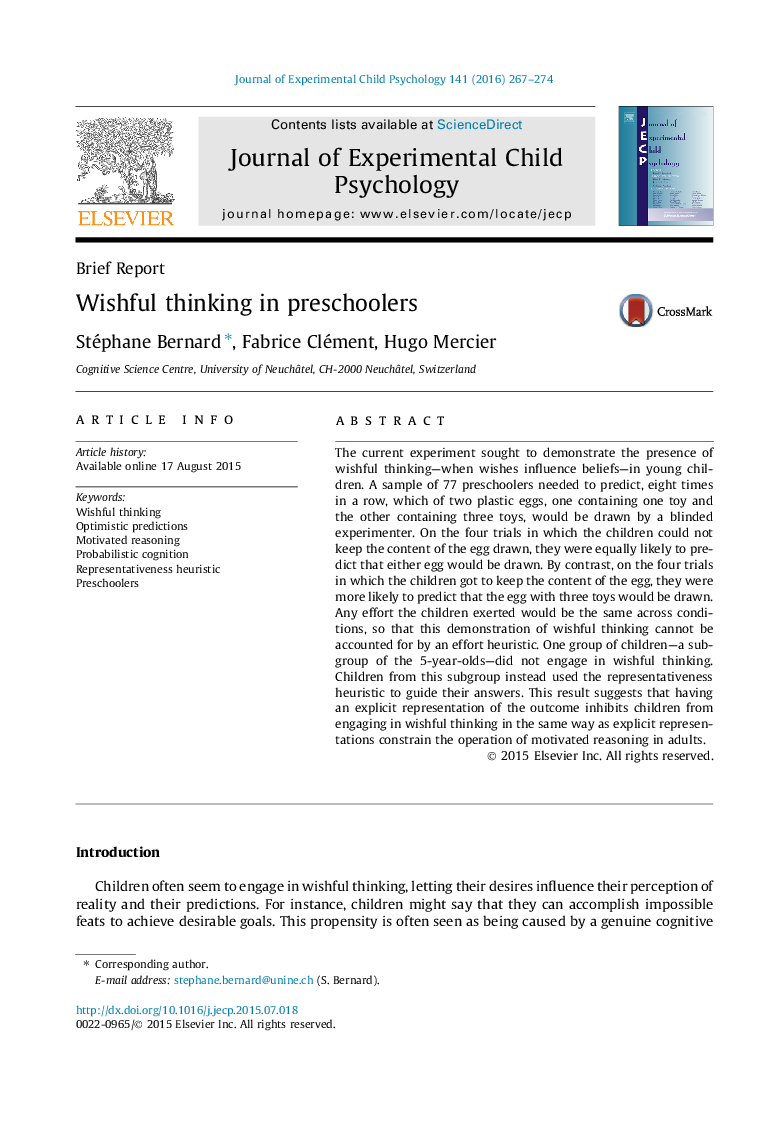| کد مقاله | کد نشریه | سال انتشار | مقاله انگلیسی | نسخه تمام متن |
|---|---|---|---|---|
| 7274986 | 1473471 | 2016 | 8 صفحه PDF | دانلود رایگان |
عنوان انگلیسی مقاله ISI
Wishful thinking in preschoolers
ترجمه فارسی عنوان
تفکر آرزو در پیش دبستانی ها
دانلود مقاله + سفارش ترجمه
دانلود مقاله ISI انگلیسی
رایگان برای ایرانیان
کلمات کلیدی
تفکر آرزو، پیش بینی های خوش بینانه، استدلال انگیزشی شناخت احتمالی، ارزیابی اکتشافی، کودک پیش دبستانی،
ترجمه چکیده
آزمایش فعلی به دنبال نشان دادن حضور تفکر آرزوی - زمانی که آرزوها بر اعتقادات تاثیر می گذارد - در کودکان جوان است. نمونه ای از 77 کودک پیش دبستانی به منظور پیش بینی 8 بار در یک ردیف، که از دو تخم مرغ پلاستیکی، یکی شامل یک اسباب بازی و دیگری شامل سه اسباب بازی بود، توسط یک آزمایشگر کور کشیده شده بود. در چهار محاکمه که کودکان نمیتوانستند محتوی تخم مرغ کشیده شوند، احتمالا به احتمال زیاد پیش بینی می کردند که تخم مرغ کشیده شود. در مقابل، در چهار محاکمه ای که بچه ها باید محتوای تخم مرغ را حفظ کنند، بیشتر احتمال دارد پیش بینی کنند که تخم مرغ با سه اسباب بازی کشیده شود. هر تلاشی که کودکان انجام دادند، در شرایط مختلف یکسان خواهد بود، به طوری که این تظاهرات تفکر آرام را نمی توان به وسیله تلاش های اکتشافی تعریف کرد. یک گروه از کودکان - یک زیر گروه 5 ساله - در تفکر آرزوهای خود دخالتی نداشتند. کودکان از این زیرگروه به جای استفاده از نمایندگی اکتشافی برای هدایت پاسخ های خود استفاده کردند. این نتیجه نشان می دهد که داشتن یک نمایش صریح از نتیجه، کودکان را از مشارکت در تفکر آرامی جلوگیری می کند همان گونه که بیانات صریحانه عمل استدلال انگیزشی در بزرگسالان را محدود می کند.
موضوعات مرتبط
علوم انسانی و اجتماعی
روانشناسی
روانشناسی رشد و آموزشی
چکیده انگلیسی
The current experiment sought to demonstrate the presence of wishful thinking-when wishes influence beliefs-in young children. A sample of 77 preschoolers needed to predict, eight times in a row, which of two plastic eggs, one containing one toy and the other containing three toys, would be drawn by a blinded experimenter. On the four trials in which the children could not keep the content of the egg drawn, they were equally likely to predict that either egg would be drawn. By contrast, on the four trials in which the children got to keep the content of the egg, they were more likely to predict that the egg with three toys would be drawn. Any effort the children exerted would be the same across conditions, so that this demonstration of wishful thinking cannot be accounted for by an effort heuristic. One group of children-a subgroup of the 5-year-olds-did not engage in wishful thinking. Children from this subgroup instead used the representativeness heuristic to guide their answers. This result suggests that having an explicit representation of the outcome inhibits children from engaging in wishful thinking in the same way as explicit representations constrain the operation of motivated reasoning in adults.
ناشر
Database: Elsevier - ScienceDirect (ساینس دایرکت)
Journal: Journal of Experimental Child Psychology - Volume 141, January 2016, Pages 267-274
Journal: Journal of Experimental Child Psychology - Volume 141, January 2016, Pages 267-274
نویسندگان
Stéphane Bernard, Fabrice Clément, Hugo Mercier,
